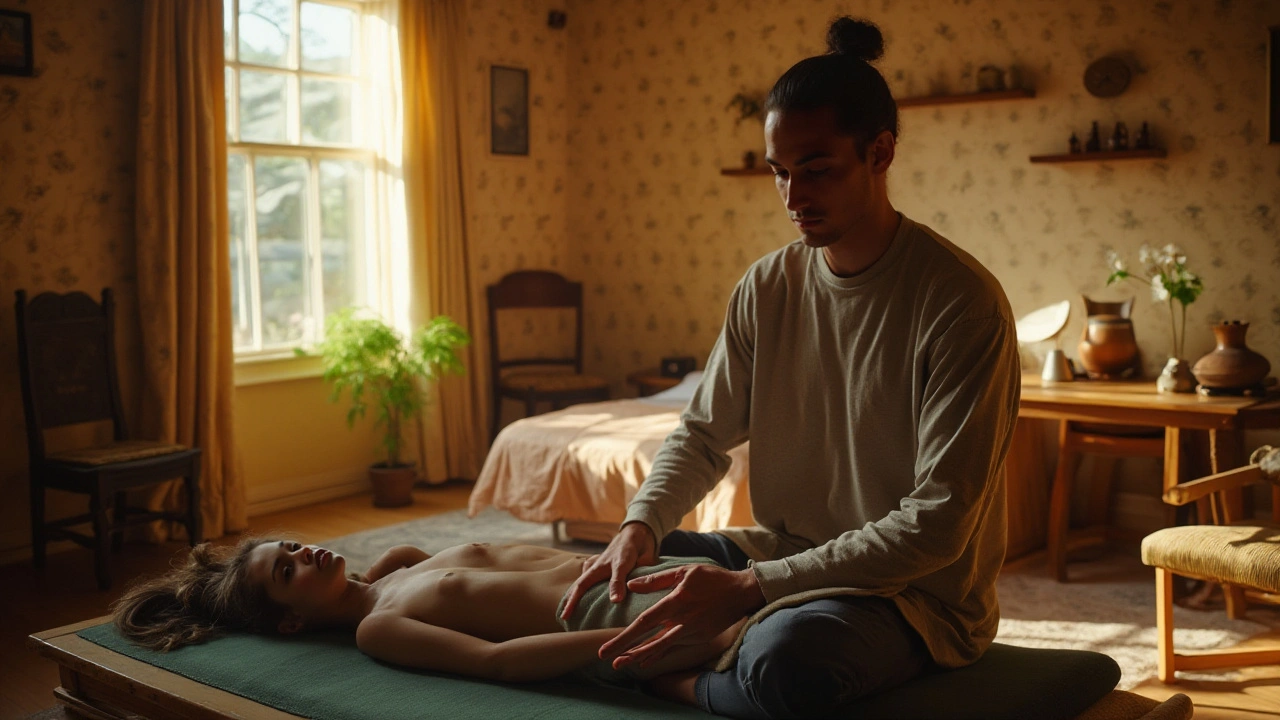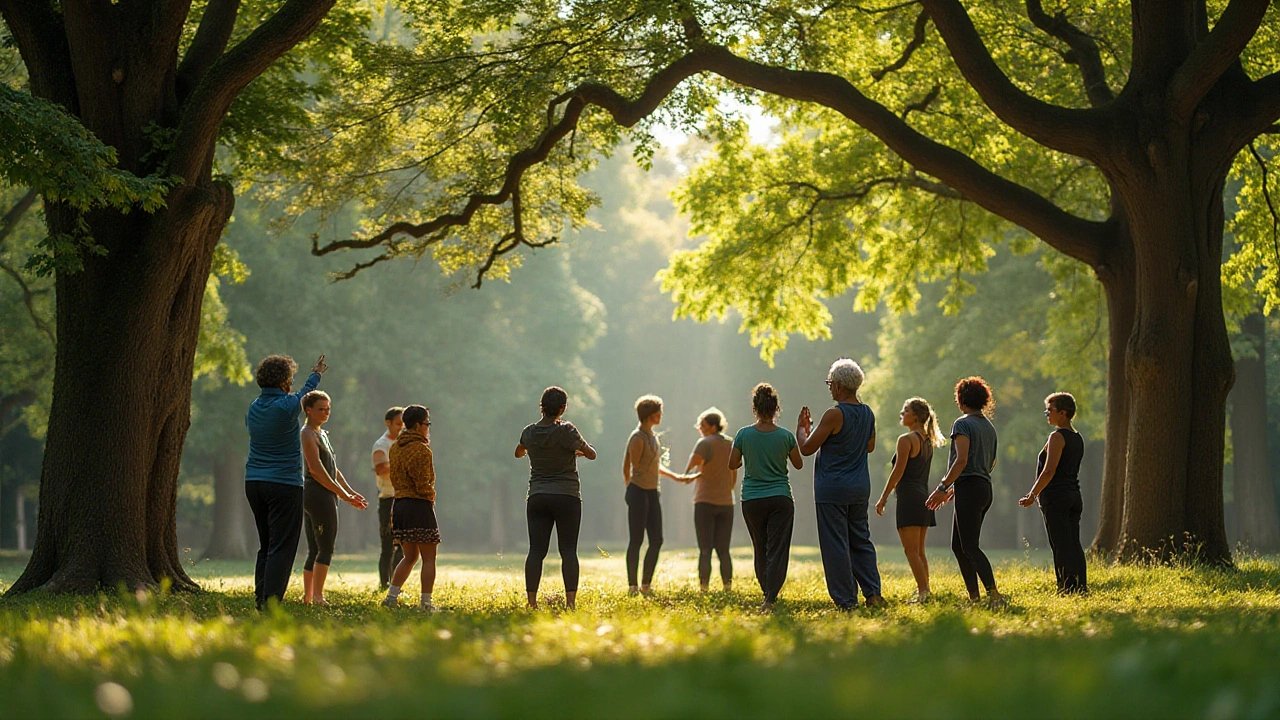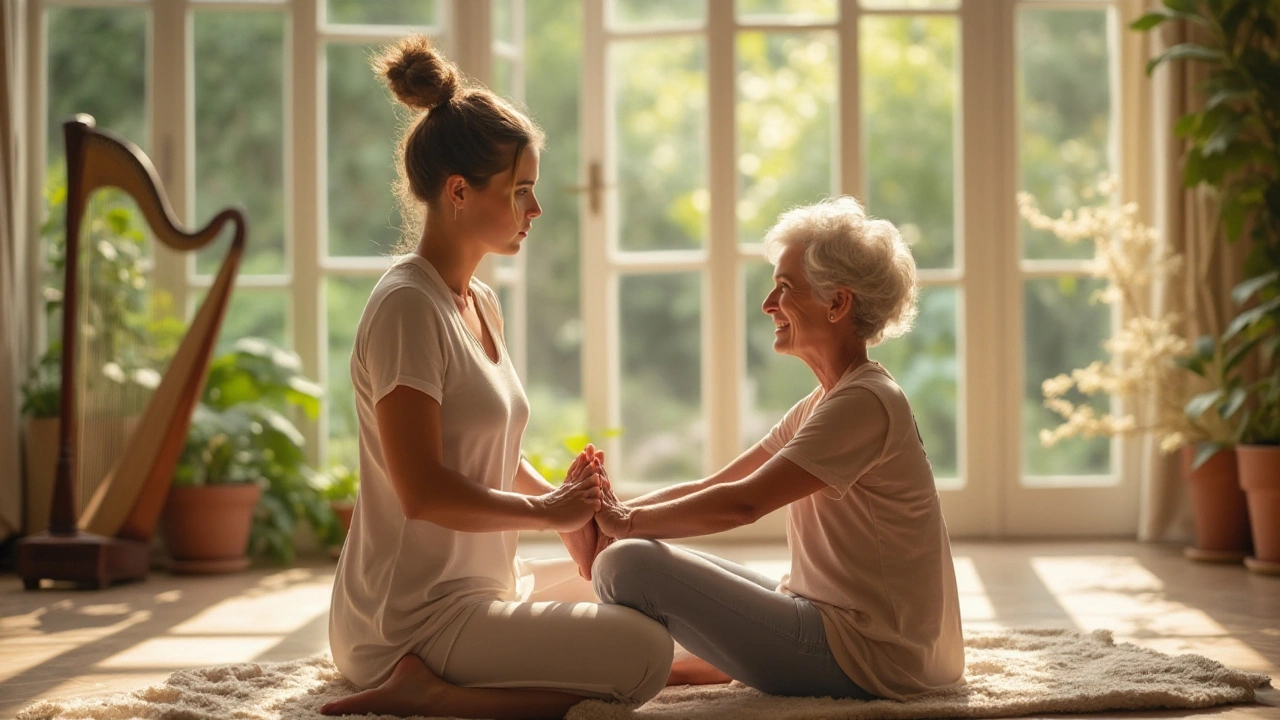Imagine a world where you find balance through simple, nurturing movements, where every touch has the power to heal and connect. Welcome to the world of Breema, an ancient practice steeped in the principles of presence and harmony. Breema invites you to step away from the chaos of daily life and rediscover the simple joy of being present in your body.
Originating from a blend of ancient wisdom and modern insight, Breema offers a refreshing take on well-being. Its practices are not about strict discipline or rigid postures, but about flowing with the natural rhythm of life. This unique approach fosters a profound sense of awareness and peace, encouraging you to embrace life's moments with clarity and compassion. Join us on this journey as we explore how Breema can transform your everyday routine into a pathway of holistic healing.
- Introduction to Breema
- The Philosophy Behind Breema
- Key Principles and Benefits
- Experiencing a Breema Session
- Integrating Breema Into Daily Life
- Tips for Beginners
Introduction to Breema
Breema is a unique approach to holistic healing that stands out in the vast world of bodywork and mindfulness practices. Its roots can be traced back to ancient traditions that emphasize the importance of being present and connected with one's body. Unlike many other forms of bodywork, Breema is not about achieving perfect poses or mastering complex techniques. Instead, it focuses on nurturing touch, mindful movement, and a deep connection between the practitioner and the recipient.
The origins of Breema are somewhat mysterious, yet fascinating. Some believe that these practices have been influenced by ancient Middle Eastern philosophies that emphasize unity and harmony within oneself and the universe. What makes Breema distinct is its emphasis on the principle of 'No Judgment.' This principle encourages participants to fully engage with the present moment, free from preconceived notions and self-criticism.
One of the foundational beliefs in Breema is that true healing can only occur when there is full presence and acceptance of one's current state. This means that Breema engages not just the body, but also the mind and spirit, creating a holistic experience that promotes both physical and emotional well-being. Practitioners are trained to offer a series of supportive and rhythmic movements that help recipients connect with their own selves and the world around them.
"Breema invites us to experience life differently," says Jon Schreiber, Director of the Breema Center.
"It’s not just about fixing what’s broken, but about realizing the potential for harmony and balance that already exists within us."This perspective shifts focus from a problem-solving mentality to one of profound self-awareness and acceptance, fostering an environment where deeper healing can manifest.
The practice is guided by the Nine Principles of Harmony, which are designed to bring practitioners and recipients into a state of balance. These principles include No Judgment, Mutual Support, and Body Comfortable, among others. Each principle plays a vital role in the Breema process, encouraging both the practitioner and the recipient to embody present moment awareness and find comfort in each movement. This structured yet flexible approach creates a powerful dynamic that is both grounding and liberating.
For those new to Breema, sessions typically begin with simple postures and gentle movements that are adaptable to the individual's comfort and ability. Whether performed in a group setting or one-on-one, the experience of Breema is deeply personal and can be profoundly transformative. Many individuals report feelings of lightness, clarity, and a sense of being more in tune with their surroundings after just one session, making it a valuable tool for anyone seeking to enhance mindfulness and body awareness.
The Philosophy Behind Breema
At the heart of Breema lies a profound philosophy that seeks harmony between the body and mind. The practice is built on the understanding that true health emerges from a deep connection with oneself, a unity that resonates through every action and thought. This philosophy emphasizes the importance of being present and fully engaged in each moment, inviting you to step into a space where you can truly listen to your body’s needs and rhythms.
Central to Breema is the concept of non-judgmental awareness—an invitation to observe without evaluating or labeling experiences. This opens up a path to greater self-understanding and acceptance, removing barriers that often distance us from our intrinsic state of balance and peace. As you explore the principles of Breema, it becomes clear that it's not solely about physical movements but about fostering an environment where mental clarity and emotional well-being can flourish naturally.
Breema’s emphasis on mindful touch and supportive movements aids in deepening your body awareness. Every session is designed to reconnect you with the ground, enhancing stability and grounding your energy. By practicing Breema, you cultivate an inner balance that reflects in your interactions and outlook on life. In this space of intricate simplicity, healing unfolds organically, driven by the synergy of mindful presence and gentle touch.
The philosophy also teaches that mutual support and acceptance are vital components of holistic healing. Breema encourages cooperation between practitioner and recipient, ensuring that healing is not a one-way street but a shared experience. This cooperation is a powerful reminder that we are interconnected, and to heal oneself is to contribute to the well-being of the collective. As you engage with Breema, you participate in a global tradition that places profound importance on embracing wholeness and harmony.
"Practicing Breema is like coming home to one's own being," notes Jon Schreiber, Director of the Breema Center. "It invites you to explore the uncharted territories of stillness and genuine connection."
Moreover, Breema is rooted in the belief that self-understanding leads to a naturally healthier state. By integrating its principles into everyday life, practitioners find themselves more centered and less swayed by external chaos. This is achieved as they learn to respond to, rather than react against, life's pressures, thus nurturing resilience and inner strength.
For those searching for a path of mindfulness and grounded serenity, Breema offers a refreshing change from conventional wellness practices. It brings you back to basics—simple, honest movements and touches that remind you of the body's innate wisdom. As you delve deeper into Breema's philosophy, you discover a treasure trove of insights that guide you not just towards physical health, but a more enriched and connected life. Breema becomes a lifelong journey of exploration, healing, and self-discovery, unveiling new dimensions of well-being at every turn.

Key Principles and Benefits
Breema is built on a foundation of principles that guide practitioners and recipients alike towards achieving balance and harmony in their minds and bodies. These principles are not just abstract ideas; they are practical and can be applied to everyday life. One of the cornerstone principles is the idea of mutual support. In Breema, the connection between giver and receiver is emphasized, where both parties gain benefit from the session by being fully present and engaged in the moment. This enhances the quality of the interaction and deepens the sense of connection and awareness.
Another vital principle is the expression of no extra, where movements are natural and efficient without applying unnecessary effort. This principle helps in reducing stress and promotes easy, flowing movements that don't strain the body. Coupled with full participation, it encourages individuals to be entirely involved and committed to what they are doing, whether it's a particular posture or a life task, promoting mindfulness which is very beneficial in all walks of life.
The Breema Center states, "When the mind, body, and feelings are working together in harmony, this is the taste of being present."This philosophy underpins the practice, emphasizing a profound state of presence that not only contributes to mental serenity but also enhances physical well-being. The benefits of this approach are manifold, ranging from improved flexibility and body awareness to significant reductions in stress and anxiety. These effects can be long-lasting as practitioners learn to carry the practice's principles into their daily lives, changing how they interact with the world around them.
Breema offers a wealth of benefits that extend far beyond the physical realm. Research and anecdotal evidence suggest that regular practice can aid in emotional regulation, increase one’s capacity to deal with life's challenges, and foster a deeper sense of self-acceptance and inner peace. As more people are encouraged to see the impact Breema can have on their lives, it's easy to see why its appeal continues to grow, reaching those searching for more harmony and mindfulness in their busy lives.
Experiencing a Breema Session
Stepping into a Breema session is like entering a serene oasis amidst life's hustle and bustle. The environment typically exudes calm with dim lighting, soft music, and a comfortable mat placed on the floor. As you prepare to embrace the Breema experience, the practitioner will gently guide you through a series of nurturing and rhythmic movements. These are designed to encourage relaxation and deep awareness of your own body. No two sessions are alike because they adapt to your unique state of being at that moment.
The practitioner applies a series of fluid and rhythmic movements that might include gentle stretches and holds. Their hands maintain a consistent touch, supporting and guiding your body to release tension naturally. This physical interaction serves as a catalyst for deeper internal awareness, creating an opportunity to connect with your inner self at a more profound level. During the session, you'll likely feel a sense of weightlessness as your body and mind begin to synchronize, fostering a true sense of holistic healing.
A unique element of Breema sessions is their emphasis on shared benefits. As a participant, you are not simply a passive recipient of healing. The practitioner, fully engaged and focused, experiences an equally enriching benefit. This exchange nurtures a shared experience that leaves everyone feeling rejuvenated. Breema teachings emphasize that both practitioner and participant find balance and harmony through the same process, highlighting how interconnection can lead to mutual growth.
Session Outcomes and Effects
Experiencing Breema is not limited to physical relaxation. Many individuals report feeling emotionally lighter, with a greater sense of mental clarity and peace. The movements and touch foster a state of mindfulness, allowing you to let go of daily stresses. Regular sessions can lead to significant shifts in your daily life, enhancing your ability to remain present and engaged.Cynthia Montgomery, a renowned mindfulness advocate, once said, "Breema's power lies in its simplicity and the profound peace it provides to every being open to its healing embrace."Perhaps the most beautiful aspect of Breema is how accessible it is. Whether you're young or old, athletic or sedentary, the practice adjusts to meet you at your level. There is no requirement for prior experience or physical prowess, which allows anyone to begin their journey towards holistic well-being.

Integrating Breema Into Daily Life
Embracing Breema in everyday life means allowing its principles to gently seep into the crevices and routines of your daily experience. At the heart of Breema is the belief that seeking harmony and balance can transform even the most mundane aspects of living. To start incorporating Breema, consider the morning, when the day is fresh and your mind is a blank slate. Begin with a few stretching movements that embody the gentle flow of Breema. These are not rigorous exercises but rather mindful movements that connect you with your body's rhythm. Consider setting aside just ten minutes to perform these movements with intentional breath and concentration on presence. This lays a foundation of awareness that can brighten your entire day.
Another way to weave Breema into daily life is by adopting its principle of "no extra" during your daily chores or work. This means focusing solely on the task at hand without unnecessary thoughts or distractions. It is a practice in mindfulness that encourages a fuller engagement with life’s simple duties. Whether it's washing the dishes, answering emails, or just enjoying a peaceful walk, the key is to be entirely there, fully present and conscious of each moment's nuances. Many Breema practitioners find this mindfulness reduces stress and increases satisfaction in their activities.
"Breema is about finding the awareness of our body and the present moment, the unity of ourselves with everything around," explains Jon Schreiber, director of The Breema Center. His words highlight the interconnectedness Breema seeks to foster.
To strengthen your Breema practice, regular self-Breema exercises, which can be performed almost anywhere, act as grounding anchors throughout the day. By bringing attention to the body's sensations, even during brief moments of pause, one can cultivate serenity amidst the usual busyness. As you integrate Breema, it’s helpful to maintain a simple journal to reflect on these moments. Such reflection can enhance your understanding of how these exercises reshape your perspective and reduce stress.
Group classes or sessions with a certified Breema instructor can provide valuable guidance and inspiration, offering fresh insights and deeper connections that bolster solitary practice. These meetings often result in shared experiences that reinforce the interconnectedness central to Breema philosophy.
Tips for Consistent Practice
Consistency is key to integrating Breema where it feels innate. Start small with daily reminders – perhaps a short pause with a few deep breaths every hour. From there, gradually build a practice with larger portions of your day dedicated to mindful Breema routines. To make body awareness a habit, consider pairing Breema exercises with daily cues. For instance, each time you finish a cup of tea or coffee or before you start a new task at work, take a moment to connect with your breath and body.
- Identify quick Breema exercises that fit your daily schedule.
- Attend group classes for community support and new ideas.
- Use breathing exercises to recenter between tasks.
- Reflect on your practice in writing to track changes and insights.
Breema lends itself to adaptability. Whether you have just a few moments or a full hour, the practice accommodates your life and seems to ask for nothing more than to be present. As you incorporate Breema, be patient with yourself, savor the journey, and allow its calming essence to unfold naturally. Over time, what starts as a practice might grow into a way of life, a retreat from the modern world's rush into a slower, more grounded existence. The benefits of a mindfulness routine such as Breema resonate profoundly, offering clarity and peace distilled from mere presence.
Tips for Beginners
Starting your journey into Breema can feel like stepping into a new world of mindfulness and connection with your body. It’s perfectly natural to have questions and maybe even a bit of hesitation. Breathe easy and approach it with curiosity rather than pressure. One of the first things to remember is the importance of comfort. Wear clothing that doesn’t restrict your movements as Breema involves gentle stretches and movements. Create a space that’s free from distractions, a quiet corner where you can focus on your practice uninterrupted.
For beginners, embracing the practice of Breema might initially seem simple, but the depth it offers is something you peel away gradually. The foundation is built on the Nine Principles of Harmony. Concepts like Mutual Support, Single Moment/Single Activity, and Body Comfortable guide you, not just during sessions but as a philosophy of life. Start by familiarizing yourself with these principles, understand them, and try to apply them in small ways in your daily routine. Breema is not about achieving the perfect posture; it’s about creating an experience that feels right for you because every movement here is a movement towards greater self-understanding and self-care.
Staying Present
Many who are new to Breema find that the emphasis on staying present and fully engaged in each moment is both refreshing and challenging. Begin with short sessions, perhaps ten to fifteen minutes, focusing solely on your breathing and the gentle motion of your body. Breema isn’t only about physical exercise but being wholly present in every action. Acknowledge each breath and each moment of – not abstractly, but as deeply connected to your body. Over time, these mindful moments will flow more easily into your daily activities, making each task less about completion and more about the experience itself. As Jon Schreiber, a noted figure in Breema says,"Breema shows us how to be present with what we are doing, and supports us in being present with our life."
Don’t hesitate to seek guidance from experienced practitioners who can offer insights and gently correct your course. Their expertise is invaluable, and most communities have sessions led by experienced hands who can share their wisdom. Remember to be patient with yourself—the beauty of Breema lies not in the destination but in the journey. Over weeks and months, you’ll find your connection deepening, not just with your body but with everything around you. This ancient practice, though simple, requires you to be gentle and compassionate with yourself, so progress at your own pace.
Consider keeping a journal where you note subtle changes, both physical and emotional. What did a particular session evoke? Was there a specific principle that resonated with your life that day? Reflecting in writing can often bring insights that you might miss during the practice itself. These notes will become a testament to your evolving journey, a guide back to your intentions, and a reminder of how far you’ve come in this entrancing practice.

